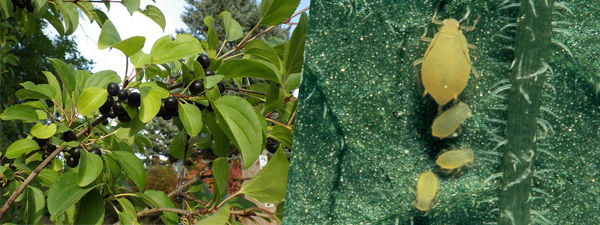Soybean Aphid
December 12, 2018

Left: In the upper Midwest, soybean aphids can overwinter by laying their eggs on its only known overwintering host: buckthorn (Rhamnus spp.). Buckthorn is commonly seen growing as shrubs or small trees underneath shelterbelt trees, along fencelines and field edges and in landscaping. (Photo courtesy of Matt Lavin, Montana State University.)
Right: By feeding with their sucking, needle-like mouthparts, large numbers of soybean aphids can reduce soybean plant vigor and growth rates.
Native to Asia, the soybean aphid has infested U.S. growing regions since 2000. It has become a serious soybean pest.
Identification and lifecycle
Soybean aphids are small (less than 1/16 inch in length), yellow-bodied insects with a distinct black cornicle or upright backward-pointing tube, which is found on the dorsal side. They may be winged or wingless. Typically, they are slow-moving and found on the underside of new growth on a soybean plant.
The soybean aphid has a complicated lifecycle that requires the presence of its overwintering host, buckthorn. An amazing aspect of this lifecycle is the female soybean aphid’s ability to reproduce live, female offspring (clones) during the summer months. These female clones are born pregnant, a unique characteristic of the soybean aphid, which explains their rapid population growth. After going through approximately 15 generations in a single growing season, soybean aphids begin to transition back to their primary host to overwinter. The aphids have a two-year lifecycle.
Crop damage
The soybean aphid uses sucking, needle-like mouthparts to extract plant juices. Aphid honeydew, a waste product produced during feeding, promotes gray, sooty mold on leaf surfaces, reducing plant photosynthesis. Drought-stressed soybeans are more suitable hosts for aphids and increase aphid reproduction rates, particularly from late May through August. If present in large numbers, aphid feeding may cause a reduction in soybean plant vigor and growth rates, as well as leaf puckering, reduced pod and seed counts and reduced yield. The extent of damage depends upon infestation levels and other variables, but it’s not uncommon to see soybean yield losses of 10 to 15 percent.
Scouting
After soybean seedlings emerge, consistent scouting is the best way to know if soybean aphids are in the field and whether or not they will threaten yields and profits. Following are recommendations on how to scout for soybean aphids:
- Late-planted soybeans seem to be more susceptible to soybean aphids. Scout these fields first.
- Scout when your soybeans are in the R1 through R5 growth stages – when aphid activity is the most detrimental to soybean yield. Treating aphids at R6 or later doesn’t seem to provide yield benefits.
- Identify 20-30 plants per field. This sample should represent 80 percent of your field.
- Early in the season, focus on the undersides of new soybean leaves.
- As the season advances, remember that soybean aphids move further into the soybean canopy.
- Count the number of aphids you find on each plant. If your findings average at least 250 aphids per plant, you are over the economic threshold and should spray.
- If you happen to find aphids concentrated on the soybean plant stem, it’s safe to assume the population is more than 400 aphids per plant, even without even counting. That’s because the stem is an inferior food source. The only reason aphids would look there for food is if the rest of the plant is overpopulated.
Problems in high or low infestation spots may be related to soil conditions, herbicide injury or invasions of other insects. If insects and damage are not easily identified, consult county Extension personnel or a pest identification guide.
Best management practices to control aphids in soybeans
When selecting soybean varieties, farmers should keep in mind that soybean varieties vary in their resistance against soybean aphids. Season-long weed control is another important factor in preventing soybean aphids from causing crop damage and harming yields.
Fields kept weed-free 2 to 3 weeks before planting by cultivation or herbicides, including burndown and preplant residual herbicides, help to control soybean aphid infestations. In no-till or limited-till situations, soybean aphids may become established on existing vegetation and move to emerging soybean seedlings once this vegetation is controlled. Good weed control will also help improve effectiveness of in-season insecticide treatments, providing better penetration of insecticide spray or granules.
The best approach to managing soybean aphids is preventive control. Starting off with a good seed treatment is an excellent way to control insects and protect soybean plants above and below the ground.
Insecticides
Leverage® 360 with Stress Shield™ protection enhances the crops’ ability to handle a variety of biotic and abiotic stresses, such as soybean aphids, thereby maximizing yields.
Leverage 360 with Stress Shield protects against aphids that suck on soybean leaves. Unlike many other insecticides, Leverage 360 moves in a way that gets to the underside of the leaves, where soybean aphids often feed. It also safeguards plants from environmental stresses and can be applied in a tankmix with a fungicide.
Another option growers have to control soybean aphids is Baythroid® XL, a pyrethroid, which performs on a broad spectrum of insect pests with fast knockdown and long residual control. Baythroid XL may be used throughout the growing season; however, application timing should be based on careful scouting and local economic thresholds.
For more information about Leverage 360 and Baythroid XL insecticides from Bayer, please contact your local Bayer representative.
Always read and follow label instructions. Not all products are registered for use in every state. Baythroid XL and Leverage 360 are Restricted Use Pesticides.